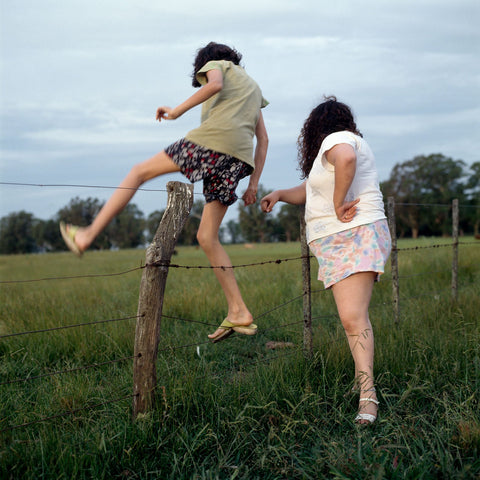Ahead of the launch of her new book Who is Changed and Who is Dead, Ahndraya Parlato talks us through some books she has loved across photography, literature, and beyond.
“When I worked at the website, I would often have the distinct thought, appearing in my head as a full sentence visualized, that I want to kill myself. By this I didn’t mean that I wanted to actually end my life but that I wanted to enact something drastic that would eliminate all my tedious problems and erase any obligation that I was not enthusiastic about fulfilling...” — Lauren Oyler, Fake Accounts (HarperCollins/Catapult, 2021)
In the above excerpt, the narrator describes a need to escape the banality of being a blogger at a lifestyle website, going on to envision death as the ultimate form of escape. While the act of looking at, or reading, a book is hardly as drastic as killing oneself, it does, for a brief period of time, eliminate tedious problems and erase obligations. Among other things, books offer an entry into unknown worlds and psyches — a minor respite from your own world and psyche.
When I pick up a written book, escapism comes from the overlap between the narrator and myself. It’s an act of observation, critique, connection and, ultimately, of submission. How much do I identify with the voice? Have I been subsumed or am I intact? When the book is one of pictures, the escapism is more like walking through a mirror and ending up in another world. I am always only myself, but I am in another place or world, another time period, or a different dream. I am seeing through the artist’s eyes, but I have been transported, not subsumed. Either way, perhaps I now have the words to articulate something I couldn’t before experiencing the book.

The Epic Story of a Love Warrior by Peter Puklus (SPBH Editions)
The Epic Story of a Love Warrior tells a fragmented history of Central and Eastern Europe (spanning WWI, WWII, and the rise and fall of Communism) through the eyes of a fictional family. Puklus structures his narrative in reverse, starting at the present and ending in 1918. Visually, the book is a cacophony of photographic subjects and styles, including color studio still-lives and portraits, black and white pictures of buildings, and studies of the human body that are reminiscent both of classical drawing as well as indecipherable performances. I love his use of repetition (not unlike the repetition of history), multiple visual strategies, how hard he asks the viewer to work to piece the images together, and the ways that collective and personal histories become indistinct.
Perhaps more than anything, I love how Puklus fully embraces the artifice of photography itself — the lack of seamlessness of his technique, the way he reveals the sleights of his hand, and the trick that there are no tricks. I respond to work where a photographer doesn’t use the medium in service of a faux authority. When the pictures acknowledge that our only possible experience navigating the world is encountering our own subjectivity over and over again, it shows that, like anyone else, they’re also just grappling with whatever issues are at hand.

Jens F. by Collier Schorr (steidlMACK)
With Jens F., Collier Schorr reimagines Andrew Wyeth's The Helga Pictures using Jens, a young, German boy. She cuts up contact sheets and prints and physically collages them into a copy of Wyeth's book, while adding her own writings and observations. Schorr leaves fragments of Wyeth's original images and musings visible to the viewer, creating a compelling and complicated dialogue between mediums, time periods, and genders.
When I first saw this book, I was excited by the ways it subverted traditional, photobook aesthetics — fresh and enlivening in both content and execution. I respond most strongly to the ways it feels both finished and unfinished and, most importantly, to the way it asks me more questions than it offers answers.

Sharon and Vivien, 2009 © Alex Katz
Conversations with Friends by Sally Rooney (Faber & Faber)
Conversations with Friends tells the story of Francis, an aloof, sarcastic, 21-year-old woman, and her best friend/ex, the charismatic and precocious Bobbie, who befriends an older, well to-do married couple, Melissa and Nick. Needless to say, much interpersonal drama unfolds and Francis and Nick fall in love — ultimately deciding that, regardless of how messy the situation is, they’ll sort it out.
What I love about this book is the way Rooney is able to convey the disconnect between what people are thinking or feeling internally and what they outwardly do or say. Rooney reveals how, though we desire intimacy and connection, we often respond to people with guarded gestures designed more to push someone away than to bring them closer. A defence against our own vulnerability makes sense for self-preservation, but is perhaps at odds with our desire to be fully seen.
All relationships come with projection, forming for unconscious, weird reasons that have little to do with anything fundamental or objective about a person, and more to do with ourselves and our contexts. Rooney’s writing exposes how our concrete actions are rooted in the unconscious, correlating more to things we may never understand than to our conscious experience; needless to say, we are all driving with our lights off.

Pictures from Home by Larry Sultan (Harry N. Abrahams; MACK)
Even though so much has been written about Pictures from Home, I had to be honest to my experience, but I’ll be brief. This work is paramount in both its combination of text and image as well as its combination of the archive and newly-made photographs. In his writing, Sultan is direct and vulnerable, probing the psychology beneath the seemingly banal construction of domesticity and familiar relationships and the ways in which masculinity is both constructed and learned.

Deana Lawson: An Aperture Monograph by Deana Lawson (Aperture)
There are many things for one to love about Lawson’s photographs, including, but not limited to, the ways they speak to the tensions between fantasy, representation, projection, stereotype, class, and both personal and collective racism. But one thing that immediately spoke to me was the intersection between sexuality and domesticity/motherhood in her portraits of women.
For many women, the title of “mother” often ends up eclipsing all the previous titles and interests we may have been associated with. Sometimes we may want this. It’s a role with clear purpose and meaning — comforting in a world where it’s easy to often feel nihilistic. However, sometimes this may lead us to feel severed or disconnected from our prior selves. In a culture where the predominant religion is based around the idea of a virgin mother, women are often desexualized after becoming mothers. I love how Lawson’s portraits of mothers subvert this ridiculous notion. For instance, one image depicts a naked woman on a couch, sandwiched between a My Little Pony action figure and a table holding a handful of framed family pictures. In another image, a couple is intimate next to their sleeping baby. Lawson shows us that the divorce, for mothers, of sexuality from the self is merely a social construct — one that can be deconstructed.

Lacuna Park: Essays and Other Adventures in Photography by Nicholas Muellner (SPBH Editions)
Nicholas Muellner is one of the most compelling contemporary artists writing about photography, writing with an equal balance of thoughtfulness, intellect and humor in a way that I have always coveted. This book is a collection of visual and textual essays. Drawing from personal history, pop culture, theory, art history, and fiction, Muellner questions the function of the photographic medium in a time when everyone is a photographer and pictures and symbols are perhaps the most common form of communication.
In one of my favorite essays, “This Slideshow Has No Pictures,” Muellner interviews psychologists about the images they conjure in their minds while talking to clients, parsing out the ways in which language and images both reveal and conceal their intended meanings.
In another of my favorites, “Color Correction,” he uses the notion of color balancing a print to explore ideas around what is lost when we aim for objective correctness, suggesting that perhaps a bit of muddiness or ‘bruising’ is intrinsic to human experience; in his words, “intimacy demands that one thing bleed into another.’

The Great Unreal by Nico Krebs and Taiyo Unarato (Edition Patrick Frey)
To make The Great Unreal, Krebs and Unarato took a road trip across America with a portable photographic lab packed into their pickup truck, making and unmaking sculptures and photographs along the way.
The project tackles the myth of the American West and subverts the authority of the American road trip as a photographic trope. Using analog practices, Krebs and Unarato play with the tension between artifice and reality, asking their viewers what has been made, changed, or found. They question the nature of photography and the act of looking itself, and perhaps conclude that all photographs are inseparable from illusion, even when we’re all in on the ruse.

Own Death by Peter Nadas (Steidl)
Written from the perspective of a man’s day before and while he experiences a heart attack, Own Death juxtaposes three and a half minutes of the narrator’s internal dialogue — observations, reflections, descriptions, and memories — with images of a single pear tree made over the course of a year in various seasons, weathers, and times of day. Both threads feel drawn out, though one is actually quite quick, revealing the way that time expands or contracts in different contexts. The relentless solidity of the tree is the perfect foil to the fragility of human existence and the passage of life.
Who is Changed and Who is Dead by Ahndraya Parlato

In Who is Changed and Who is Dead, Ahndraya Parlato uses the life-changing events of her mother’s suicide and the birth of her children as the genesis for an expansive project exploring the contradictory and complex conditions of motherhood. The resulting image-text book threads the political and historical with the deeply personal, bringing together narratives from across genres and generations to create a nuanced and compelling body of work.
Hardcover
July 2021
€40 £35 $50
Pre-order
The signed edition includes an extra image plate signed by the artist and glued into the inside back cover.
€45 £40 $55
Pre-order signed edition





